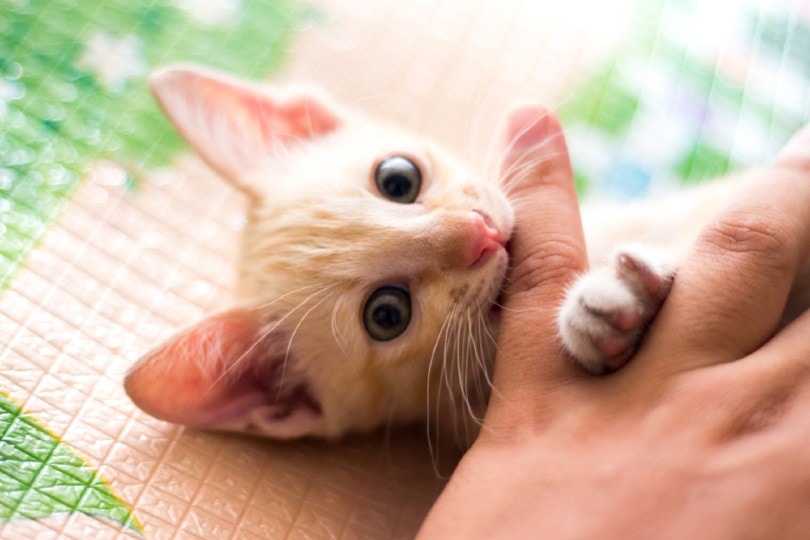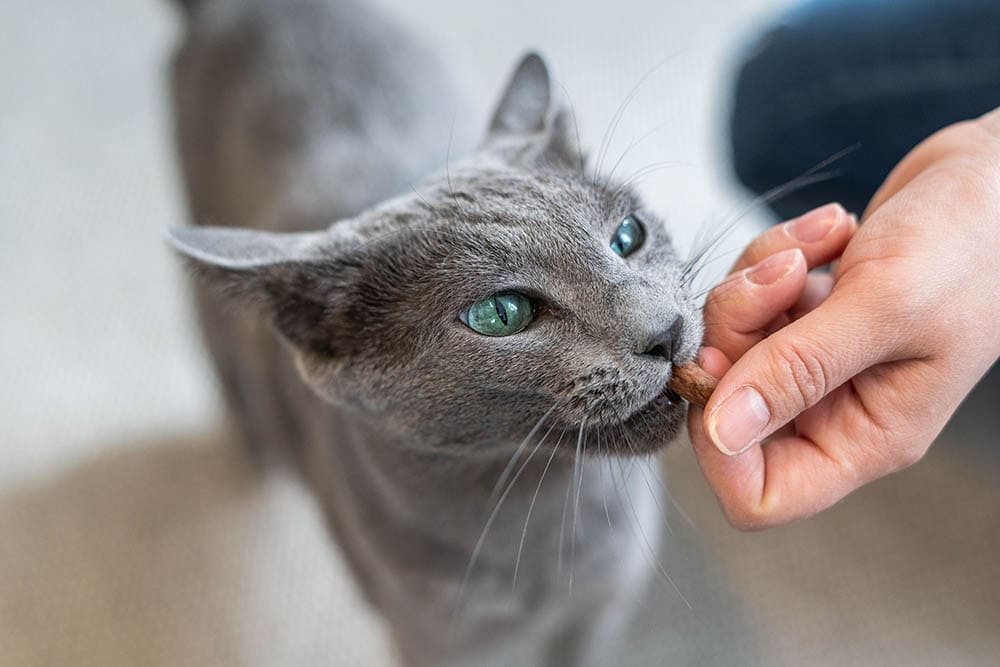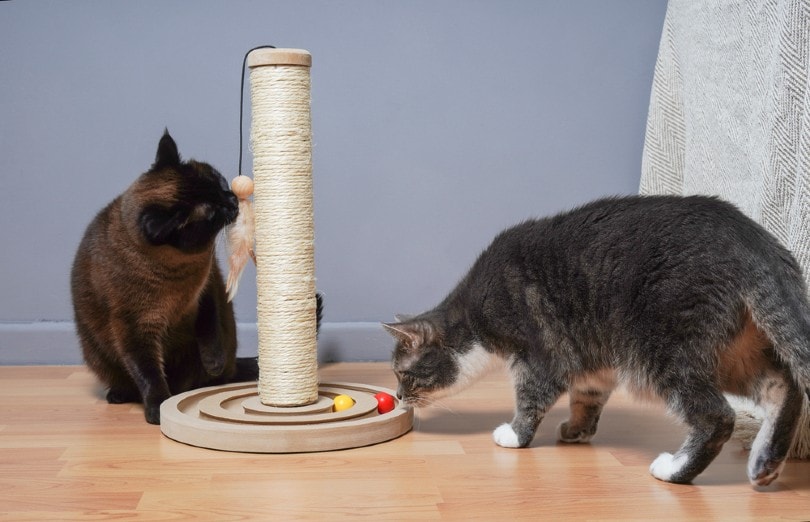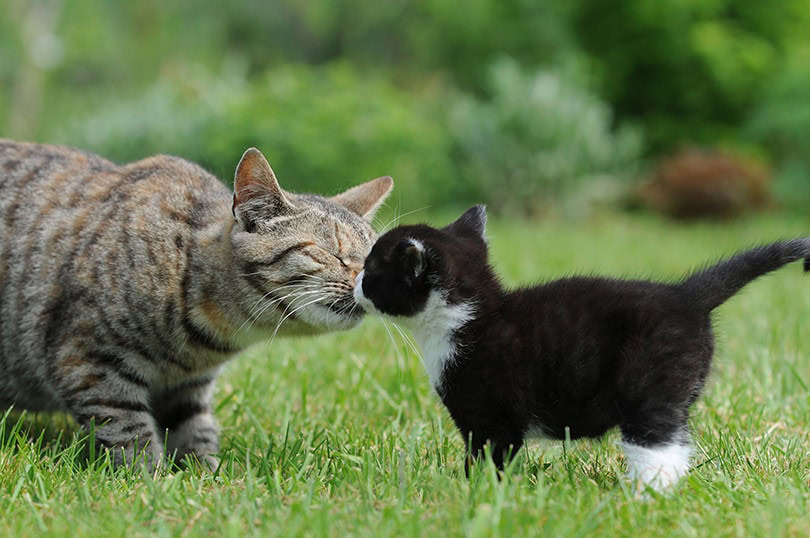VET APPROVED

The information is current and up-to-date in accordance with the latest veterinarian research.
Learn more »Adding a new kitten to your home is exciting, but it’s also a time of stress. Nobody is going to feel this stress more than the older cat in your home, however. They’re used to getting all the attention and not needing to share their resources, and now you’re bringing in another furry friend to compete with them.
While it’s a big transition for your cat, if you do everything right and give them time, they can come to enjoy their new feline companion. So, what do you need to do to ensure a smooth transition?

The 5 Tips for Introducing a Kitten to Your Older Cat
1. Prepare Your Cat and Your Home

Just like you prepare older children for the arrival of a new sibling, you need to do the same for your cat. That said, you can talk about it with your cat all you’d like, but they won’t know what you’re saying.
A better strategy is to start setting up the new litter box, toys, and food and water bowls in a separate room or area and let your cat briefly investigate. Cats are smart, and when they’re exploring, they’re slowly getting used to changes in the home.
Just don’t do it too far in advance, and make sure your cat has a chance to explore the new setup but do not let them get too cozy. After all, this area will be dedicated to the new kitten and should not be overwhelmed with the smell of your older cat.
Consider setting up a pheromone diffuser in the area where the new kitten will reside, and where the two cats will eventually be introduced. Ensure you will have a sufficient number of litter boxes, as well as scratch posts, toys, and beds. Cats need to have their own resources and this will reduce territorial disputes. Speak to your vet as well and make sure both your older cat and the upcoming kitten as well have received all of their vaccinations.
2. Get Them Curious Through Scent Exchange
Cats explore their world through smell, so what better way to introduce them to their new companion? We recommend setting up your kitten and cat in separate parts of the house for a few days.
Give each one everything that they need, and spend time with both of them. Afterward, exchange some of their toys or blankets which contain their scents, so they start becoming familiar with each other’s presence. Your cat and kitten will both know that there’s another feline in the home, and they’ll want to meet them. As the saying goes, absence makes the heart grow fonder, and curiosity is a cat’s middle name.
After initial scent exchange over several days, the first interaction is far more likely to go well.
3. Let the Treats Flow

After the two cats have become familiar and relaxed about the scent exchange, allow the cats to see each other first without interacting, through a glass window or door, or a crate, ideally by keeping the kitten in the crate. Ensure there is a safe hideout spot in the crate where the kitten can withdraw if they feel overwhelmed, and any insecurity or attempts at hissing should be redirected by using treats and toys.
Everyone loves a snack and your cats are probably no different. Give both of your cats plenty of treats to put them in a good mood, and as a boost, use catnip. Keep the treats coming throughout the first introduction, making both cats feel comfortable around each other.
A snack social is an excellent way for your felines to meet each other for the first time.
4. Practice Makes Perfect
As tempting as it may be to just let the kitten out of the crate and let them interact straight away, especially if they seemed to have kicked it off well from the start, it’s important to be patient. Get them interacting through the crate or another obstacle through which they can still see and sniff each other but not have full access. When they feel entirely comfortable around each other, which could be a day or two, or a couple of weeks, finally let them be free-roaming in the same room. Prepare lots of tasty treats and toys to be able to quickly distract them if things get heated. However, ensure you are tuned into their body language as small signs of uncertainty are not uncommon at this stage, so don’t be discouraged.
A simple hiss or swat of the paw isn’t necessarily the end of the world, and it’s part of the process. Redirect their attention with toys and treats, stay calm, avoid shouting, give them space, and let them work things out on their own while still supervising their behavior.
5. Give Everyone a Safe Space

We all need an area to get away from things from time to time. This is important for both your cat and the new kitten. Give them somewhere they can go to get away from everything. It could be a separate room, a cubby hole, a crate, or a cat bed.
Everyone needs their own space, and if you ensure that your cat and kitten have their own spaces where they won’t be disturbed, as well as their own resources such as bowls, toys, scratch posts, beds, and litter boxes, it’s far more likely that the interactions will go well, and they’ll become happy family members!

Final Thoughts
It’s natural to stress out a bit about bringing a new arrival into the home, especially if you have an older cat.
But keep in mind that kittens are far more malleable than older cats. This means if you’re introducing a kitten to an older cat, the kitten should adapt more easily to the older cat’s expectations, with the older cat accepting them, as long as their gradual introduction is handled with patience and supervision.
It might take a few days or even a few weeks, but everything should settle down, and everyone will get used to their new roles. Just ensure both cats’ needs have been met in full and give it some time.
Featured Image Credit: schubbel, Shutterstock












